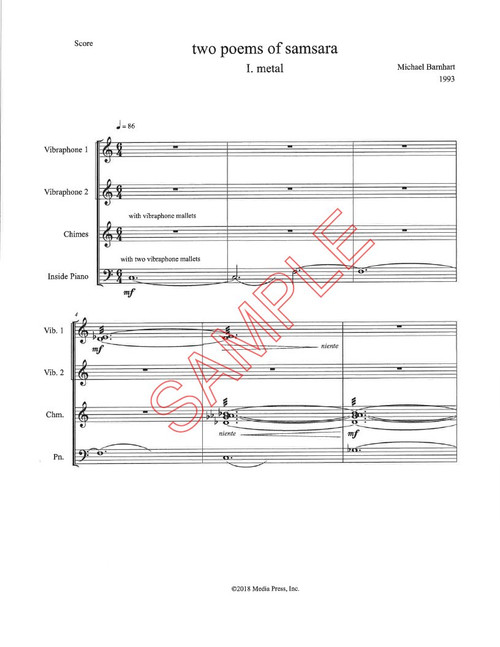Includes score and parts.
Want it now? Click here to purchase a digital copy of this product.
Review from Percussive Notes (2021):
two poems of samsara
Michael Barnhart
“two poems of samsara” is a study in cyclicism, in terms of both the core concept of the piece (Samsara, as defined by the composer as “the Hindu cycle of birth-death-rebirth”) and the unfolding ostinati and da capo repeats used to musically convey that concept. The quartet is ostensibly in two movements (“I. metal,” for vibraphones, chimes, and struck piano strings, and “II. wood” for marimbas), although the second movement is more-or-less attaca, and the entire piece is clearly intended to be performed in its entirety. The work is both hypnotic and mechanized, as the majority of the material comprises repeating melodic fragments that undergo rhythmic and harmonic transformation but never yield in their unrelenting paths.
The piece lasts a little over seven minutes, with a longer, placid first movement and a shorter, more frenzied second movement. The first movement reminds me of Balinese gamelan, with its interlocking composite melodies, although with a decidedly Western scheme of undulating polyrhythmic overlap. The instrumentation is a bit curious; the chimes part is highly atypical, entirely consisting of long, gently emerging chords rolled with vibraphone mallets, as opposed to the hammered punctuations typically played thereon. Similarly, the piano part is a series of single notes (most of which last multiple measures each) played on the string with a vibraphone mallet. The effect is akin to that of a pitched gong, which would be appropriate given the gong’s similar role as a cadential marker in non-Western music. In fact, with the part going no lower than B2, I wonder if it might even be more satisfying to play the part on gongs instead of the piano strings, if one has the instruments available; the piano technicians would certainly prefer the latter.
The second, all-marimba movement is more active, thanks to the increased rhythmic speed of the parts, although it also feels more static due to the additional density. As with the first movement, the piece progresses through a series of shifts in harmonic and rhythmic relationships and reminds me of some of John Luther Adams’s percussion music (albeit shorter). Performers will need to lock in 3:2 and 4:3 polyrhythms at fast speeds for the piece to be successful.
“two poems of samsara” might be a natural companion piece to minimalist works by Adams, Reich, or Glass, although its relative shortness will create a programming imbalance without additional pieces in the mix. It is a highly engaging, interesting study in rhythmic and harmonic transformation, and would be a great addition to a university percussion ensemble concert.
—Brian Graiser







